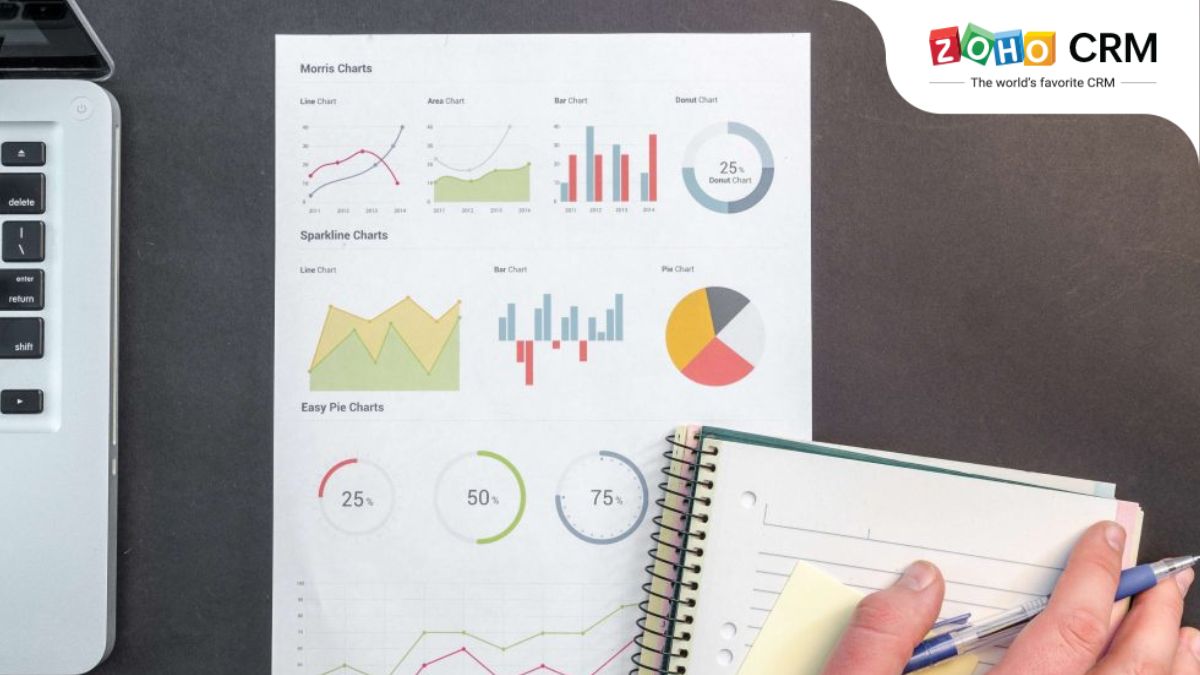- HOME
- What's New
- 10 website metrics that every business needs to track
10 website metrics that every business needs to track
- Last Updated : August 7, 2023
- 890 Views
- 8 Min Read

“Hey, how’s your website performing?”
That’s a broad question. Obviously, if someone ever asked you that, you’d have to go with “good,” “not bad” or “why does that matter to you?”, but if you’re asking that question to yourself, you’ll find that there’s no simple answer to it. Your website’s health is not just about how many visitors you entertain every day; it’s derived from a number of vital signs, each of which has a varying degree of effect on lead conversion.
But first, you need to define what a healthy website is. Depending on the purpose a website serves, some metrics are more important than others, while some have little to no impact. Despite that, businesses need to track those numbers, as they can help you analyse the performance of a website in detail.
Here’s a list of popular metrics that you should keep track of. If you take these into consideration and enforce changes that yield better numbers, you’ll be able to populate your CRM with quality leads, who are more likely to sign a deal.
1. Web Traffic
Web traffic is the number of visitors to a website in a time frame, which is the most common metric that businesses obsess over. Although performance is more than just traffic, this is still a great indicator of how popular your website is. High traffic means that your marketing efforts are paying off, as consumers are now flocking to your website. Still, whether or not they take an action depends on the quality of the content you host.
If your traffic is low, your business will lose steam unless you work on solutions. If no one’s visiting your website, you have nobody to do business with. To boost traffic, you can take actions like improving your marketing campaigns, hiring an SEO analyst to help you rank higher on Google, optimizing your website for mobile devices and tablets, decrease the load time, and shortening the URL. You won’t have an adequate data set to measure the metrics mentioned below if your web traffic is low.
You can look at the traffic of specific pages to see which content performs better than the rest. Customers visit links on your website that interest them, which lets you know what works. If a certain type of blog or video brings in a sudden surge in traffic, you can replicate that success by hosting more content like it.
2. Unique Visitors
You can narrow down your traffic numbers to see how many of those visitors are unique and how many of them are returning. Unique visitor count indicates how well you attract new users, while returning visitor count indicates how well you retain old users.
If you manage to retain a lot of new visitors consistently, you’re amassing a loyal follower base who play an important role in the growth of your website. If you’re not retaining enough visitors, improve the value of your content; make sure it incites and invites users to come back for more. If you’re not getting enough new visitors, it’s about time to make your website more discoverable on search engines, social media, and blogs.
3. Pages Viewed Per Session
How many pages does an average user open can help you understand how interested that visitor is in what your website offers. More pages viewed per session indicates more interest in the content or the product.
However, it could also mean that users are finding it hard to locate the information they’re looking for. If users visit fewer pages per session, but the conversion rate still looks good, it’s likely that these few pages provide enough information to secure a deal. Because of this, these numbers are better used in conjunction with other metrics, like time spent on a page and search terms.
4. Traffic Source
Apart from knowing how much traffic you handle every day, it’s important to know where that traffic comes from, too. You can renew your focus on sources that bring in less traffic, understand what’s working and what is not, and make changes accordingly. There are five important sources of traffic: direct, referral, organic, social media, and paid.
Direct traffic is the measure of the number of visitors who entered your URL in the address bar to visit you. This indicates how familiar your website is. If your website is popular online, and if your visitors are compelled to frequent your website regularly, people are more likely to reach your home page directly.
Referral traffic shows the number of visitors who were referred to your website from external sources. These referrals can be from many channels, such as guest posts you wrote, blogs or a videos that cite you, wikis, business lists, or even social media posts from other customers.
Organic traffic comprises visitors who were looking for something on a search engine and ended up finding your website there. SEO is an integral part of online marketing, and your efforts at improving it will be reflected by the traffic you pull organically.
Social media can bring in a ton of traffic, depending on how popular your business and your content are online. Create posts, blogs, images, videos, and news that are shareable, and engage with consumers online to generate buzz. Your active and healthy presence on Facebook, Twitter, LinkedIn, Instagram, and others social sites can make a sizeable addition to your website traffic.
And finally, advertisements. It’s hard to thrive as an online business that doesn’t invest in digital ads. If you need traffic from word of mouth, you need to get the word out first. Buy space on platforms like search results, social media, news, blogs, or apps, and monitor how every ad performs. Some ads yield high traffic and some yield none. Consider the placement and the content. Ultimately, your website needs traffic and you need to invest wisely in it.
5. Bounce Rate
Bounce rate is the percentage of visitors who visit your website, only to hit the back or the close button within a few seconds. Bounces could occur due to a range of hassles, like slow load time, broken links, bad website style, obtrusive ads and scripts, or poor choice of keywords. High bounce rate might also indicate that the content is irrelevant to the ad they clicked on. Bounce rates are best used in conjunction with other metrics so you can figure out the cause and double check if the numbers are in fact true, as Google Analytics is infamous for recording false instances.
Make sure you optimize your website to load faster on mobile devices, as that’s one of the biggest contributors to bounces. Do not bombard the user with obtrusive ads, signup forms, and pop ups. Keep the website design simple and friendly. Create landing pages that reflect your advertisements, as small businesses tend to use their home page as the redirection link for any keyword or ad they use.
6. Average Time On Page
Just because visitors don’t leave your website right after they land, doesn’t mean you’re in the clear. How much time they spend after the bounce threshold can reveal a lot of information, too. Engaging, interesting content keeps users’ attention for a longer period than bland, uninformative content. Monitor which sites perform better and follow a formula that works.
There’s always an exception. Longer average times could also be because the content is hard to understand and shorter average times could also mean that information can be obtained just from skimming. Sometimes people might have left their screen open to come back later. At times like this, it’s important to make an informed decision on whether the content warrants the time people spend on it.
7. Landing Pages
Which page do visitors land on? Sometimes, one sensational blog could drive traffic like never before. One perfect email can rake in visitors at an amazing rate. What brought them to your website tells you a lot about what they’re looking for. You can segment audiences based on the page they land on, group people with similar interests, and create marketing campaigns accordingly.
Landing pages tell you which ads, emails, or blogs are bringing in leads. Users will look for what you promised them in those promotional materials, making it easier or harder to begin a conversion, depending on your take on personalised marketing.
8. Exit Pages
An exit page is the last page that a customer was on before they chose to exit your website. At some point, every customer has to leave, so what matters is whether they exited before completing a desired action. If this activity is completed, there’s nothing much to worry about which page they leave from. If not, you need to analyze if their decision to leave was influenced by the page itself.
Maybe the user was checking out your website, and they’re planning to come back and read more. But sometimes, it could be the page that drove them away. If a few pages have a high exit rate, revamp the content to make sure it’s not aversive. If a user exits after scrolling a few folds on a site, there’s a good chance that something they read turned them away. Use scroll maps to locate the exact fold in which they exit, and redesign the content.
9. Search Terms
Having a search bar in your website can be liberating for visitors, especially when you have lots of links in your repository. It makes accessing data easier for users, and also helps you understand what people are looking for on your website. If people search for a particular topic a lot more than the others, it’s better to provide a quick link on the home page for ease of access. Make sure your header and footer are filled with links that users would look for and include a site map to make it easier for users to navigate through your website. This way, users can read what they want in one click and make decisions quicker.
10. Action Rate
Finally, one of the most important metrics to track is how often visitors complete a desired action after they visit your website. This action can differ based on the intent of your marketing campaign. Do you want people to sign up for an email list, answer a poll, or read your blog? You’ve created a site that serves this intent, but how often do people complete the action? After all, that’s where the success of your website lies.
That’s why it’s important to make your website appealing and inviting enough to keep a visitor engaged. If the action rate is lower than you want, you need to find out why. In most cases, it ought to do with one of the metrics mentioned in this article. If not, you need to change your strategy to get visitors to complete the action. Improve the content, polish the page, create meaningful promotions, and incentivize their actions.
With the right analytics tools and a CRM, you can use your website to generate business that’s personalized for every user. Knowing the ins and outs of your website requires a careful eye on metrics, and improving those numbers consistently is the best way to ensure that your website remains a strong source of leads for your business.
Do you actively track any other metric that’s not mentioned here? Let us know your thoughts and additions in the comments below.


